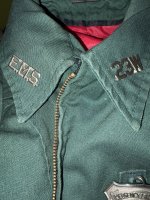Circa 1983 the rank structure was: Emergency Medical Specialist Level 1 (EMSS1) aka - EMT - Formerly known as Corpsman and before Health & Hospitals Corporation it was Ambulance Technician under the Department of Hospitals.
Emergency Medical Specialist Level 2 (EMSS2) aka - Paramedic created in 1974.
Supervising Emergency Medical Specialist Level 1 (SEMSS1) aka Lieutenant.
Supervising Emergency Medical Specialist Level 2 (SEMSS2) aka - Captain.
Above that we had Deputy Chiefs, Assistant Chiefs (Borough Commanders) and an array of one and two star Chief Officers that were in charge of things like Training, Motor Transport Division, Field Services, Special Operations and some Headquarters staff that I never really interacted with.
We had 5 Divisions Manhattan was 1 , The Bronx was 2, Brooklyn was 3, Queens was 4, Staten Island was 5. Everyone was on their own radio frequency with the exception of Staten Island and Brooklyn South if I recall correctly. The might have shared the frequency.
Supervision at the station level on paper was similar to today with 1 Captain as Commanding Officer and 9 Lieutenants. That could vary depending on fluctuations in available bodies. We had three tours in a 24 hour period with Tour 1 effectively being 0001 x 0800, Tour 2 being 0800 x 1600 and Tour 3 being 1600 x 2400. Those hours were just a framework because we often had oddball start times that fit the historical call volume of a specific neighborhood. We also were ran the most units on days and evenings and effectively dropped down almost 1/3 of units in service on the midnights because call volume (presumably) dropped off.
Tour staffing was Captain worked Monday to Friday day tours, Lieutenants, worked all three tours on a platoon chart (fixed hours of 5 days on 2 days off 5 days on 3 days off) one Lieutenant for the station operations (Desk) and one for the field (patrol) but you very rarely if ever saw a field supervisor back then. Ambulances were staffed with Either two EMT's or Paramedics same platoon chart as the Lieutenants, Very infrequently till 1984 ish ? you worked with an MVO- Motor Vehicle Operator and not an EMT Partner and it was only BLS units. Medics always rode with a Medic partner. The Stations were Huge as far as numbers of units they turned out each tour. The numbers of stations is not nearly what is is today. Bronx had 3 stations now has 10 ! I have to check on radio designations because they have changed over the years so stay tuned.

